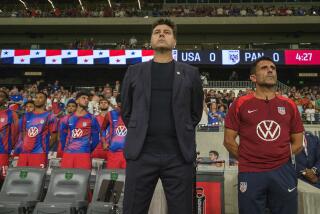Germany Wins, 2-1, in Tropical Silverdome : Soccer: Experiment with indoor natural grass appears to succeed, but heat and humidity are daunting.
- Share via
PONTIAC, Mich. — Amid the hubbub leading up to the first international soccer match ever played indoors on natural grass, there was the small, philosophical voice of Graham Taylor.
Taylor, whose position as coach of the English national team is nearly as closely watched as the special grass at the Silverdome, was the lone voice of doubt about the idea of taking the sport of mud, wind and rain indoors as Germany played England in the final match of the U.S. Cup ’93 on Saturday.
“The beauty of football is its uncertainties,” he said Friday. “The more uncertainties you take away, the more boring it gets. Weather and climate play a part in our game. I wonder, when I look at a stadium like this: Is it taking away some of the uncertainties and beauty of the game?”
Saturday’s game, which Germany won, 2-1, was not without its uncertainties. And, while there was no weather, there was a steamy, stultifying climate under the Silverdome’s roof. Suffering along with the players was a crowd of 62,126, the largest for a soccer match in the United States since the 1984 Olympic soccer final at the Rose Bowl.
The heat--79 degrees--and humidity--92%--in the arena would seem to nullify the domed stadium’s main strength, and a reason for it’s selection as a venue for the 1994 World Cup--to create near-perfect playing conditions. There is no air conditioning in the Silverdome’s seating area.
But it was the grass, not the atmosphere, that drew the most attention. Both teams practiced Friday on the 14,000 square feet of hybrid grass that will be used for four matches in next summer’s World Cup. The surface was left with the usual divots and bare spots, which were carefully repaired before the game with green-dyed sand.
Players said the field was drier than they liked, but otherwise deemed it perfect. Three more games will be played on the field, to simulate World Cup conditions, then the nearly 2,000 individual containers of grass that create the crazy-quit surface will be disassembled and returned to the Silverdome parking lot, to be reassembled next June.
“People are going to be out there looking for divots with microscopes,” said Roger Faulkner, president of the Michigan World Cup Host Committee. “But if you look at Soldier Field (where Germany and the U.S team played last week) after the game, I’m sure there were hundreds of them.”
The German players, many of whom play professionally in Italy, appeared to handle the sauna-like conditions better than the English.
“It was too hot and humid, but I play in Rome, we are used to it,” said Karlheinz Riedle, who along with his German teammates earned a $20,000 bonus for winning the two-week U.S. Cup tournament. Brazil was second, the United States was third and England, which has been under fire while performing badly in World Cup qualifying, was fourth.
Germany controlled the game, and the ball, from the outset. German captain Lothar Mattaeus set up the first goal on a pass to Stefan Effenberg. Effenberg trapped the ball to control it, dribbled around defender Gary Pallister and knocked it past English keeper Nigel Martyn in the 26th minute.
England tied the score early in the second half on a give-and-go from Paul Ince to John Barnes and back to Ince then to English captain David Platt, who scored past Bodo Illgner.
Jurgen Klinsmann, one of the stars of Germany’s 1990 World Cup-winning team, scored the winning goal, putting in Christian Ziege’s shot as it bounced off of the post.
Klinsmann, who scored four goals in the U.S. Cup, was voted the tournament’s most valuable player.
The six-game U.S. Cup attendance total was 286,761, an average of 47,794. Tony Meola of the U.S. team was voted the tournament’s outstanding goalkeeper.
More to Read
Go beyond the scoreboard
Get the latest on L.A.'s teams in the daily Sports Report newsletter.
You may occasionally receive promotional content from the Los Angeles Times.







